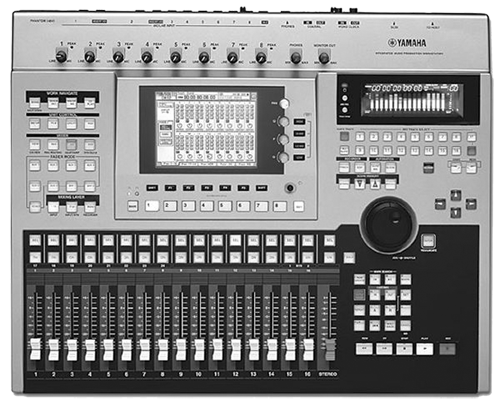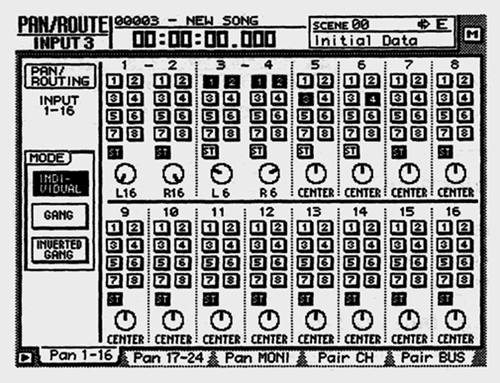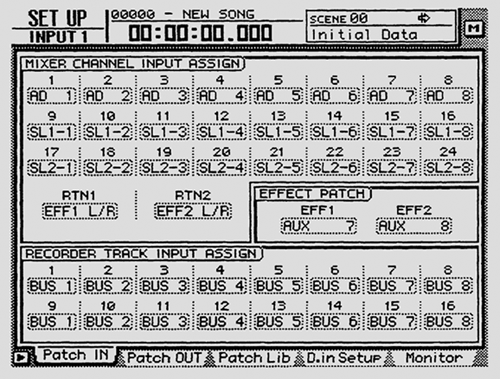
by Steve Cunningham
All-in-one hardware audio workstations are popular among small recording studios, production companies, and bedroom musicians. They’re also used by some radio production types who like to work at home, after hours. Welcome to the club, all ye who have no life.
Yamaha has presented us with yet another tool to ensure we continue to have no life, in their AW4416 Audio Workstation. The AW4416 combines a 44-channel digital mixer with EQ and dynamics on every channel, and a 16-track digital recorder with editing and the ability to record on all sixteen tracks simultaneously.
The AW4416 records 16- or 24-bit uncompressed audio at 44.1 or 48 kHz. You get stereo digital input and output, built-in SCSI for backup, dynamic and scene automation, motorized faders, and sixteen handy sampling buttons for triggering effects or parts of recorded tracks. There’s plenty of processing power, including two onboard multi-effects processors and 4-band parametric EQ and dynamics processing on each channel. A CD-RW drive fills a slot in the front of the unit so you can generate an audio CD without leaving your desk.
But life is not all beer-and-skittles with the AW4416. There are annoyances and some weaknesses to this box, especially in the editing department, as we shall see.
OUT OF THE BOX
For a small package, the AW4416’s appearance is impressive. Banks of lighted buttons and knobs are spread across the surface of an attractive silver wedge. A soft rubberized mat surrounds the faders and transport controls. Labeling is clear and easy on the eyes. Everything feels solid, too; the buttons offer a reassuring resistance, the switches emit a satisfying click, and the knobs appear robust. The seventeen moving faders (16 channels plus stereo master) are short at 60mm each, but feel smooth and positive.
There’s lots of other stuff in the box, including four manuals, a video, AC cable, a demo CD, along with an internal CD burner and a box containing a 2.5" 12GB hard disk. Hmmm. I got the feeling I’d need tools soon, and I was right.
If you’ve read my reviews in the past, then you know that I like to open the box, plug in the unit and turn it on, and begin fiddling around right away. I did this, and then realized when I got an error message that there was no hard disk in the unit. I then noticed that Yamaha taped a note on the inner box, the second page of which warned of disaster if I powered up before installing the hard drive. No disaster occurred, but I don’t understand why Yamaha shipped the unit without drives installed. Installing the drive and the CD-RW burner was not too much of a challenge, but it was an annoying twenty-minute detour. Those of you who are easily intimidated by handling static-sensitive devices should give the job to a tech.

GOZINTAS AND GOZOUTAS
There are eight analog inputs in the AW4416. Inputs 1 and 2 on the rear-panel jackfield sport both XLR and TRS connectors with insert points. The remaining inputs just have TRS jacks, but their levels range from -46 to +4 dB, still good enough to function as mic preamps. (Yamaha used TRS jacks to save space.) This arrangement works if you have a patch bay and the necessary cables, but I’d hoped for the option of plugging all my mic cables directly in to the AW4416. However, the layout is common on these combo boxes so I wasn’t too disappointed.
All channels feature dedicated trim pots and peak LEDs on the top panel. A rear-mounted switch handles phantom power for inputs 1 and 2, but I wish there was a status LED to tell me if phantom was on.
Input-channel 8 has a second unbalanced 1/4-inch jack for electric guitars, basses, and other electric instruments. I checked this out right away. I plugged in my trusty Rickenbacker 330 and inserted an amp-simulation effect from one of the onboard processors. The quick-and-dirty crunch sounded pretty good, though it wouldn’t fool a purist.
Directly below the inputs is a pair of RCA tape-out jacks, four unbalanced 1/4-inch Omni assignable outputs, and a pair of +4 dBu balanced TRS monitor outs. Why does Yamaha use both balanced and unbalanced connections? Again, it’s common in a product intended for both pro and consumer markets.
Rounding out the rear panel are two option slots for adding more I/O, a stereo headphone jack, S/PDIF in and out, word clock in and out, jacks for a footswitch and a 9-pin mouse, a serial connection for a pre-USB Mac or a PC, and a SCSI port. There’s also a trio of MIDI jacks.
As we’ll see, you can directly tap any channel signal and send it virtually anywhere in the recorder, or route any of 50 different signals to the mixer’s four Omni outputs. The AW4416 has a full-blown digital patchbay under the hood — a good thing, considering how many channels of digital audio can flow through the AW4416 at any given moment.
The unit’s routing capabilities become extra important when you add digital or analog I/O cards into the aforementioned two expansion slots. Available cards include ADAT lightpipe (eight channels of input and output), TASCAM TDIF digital (eight I/Os), AES/EBU digital (eight I/Os), XLR analog (four in or four out) and TRS analog (eight in).
You can mix and match formats in the slot cards as well. For example, you could add one card for ADAT lightpipe digital I/O, and pick up an additional eight TRS analog inputs from a second card in the other slot.
THE FRONT PANEL
A glance at the front panel reveals the AW4416’s heritage. If you’re familiar with Yamaha’s digital mixers, particularly the 02R, you should feel right at home.
The AW4416 presents a lot of information in a small space. Measuring approximately 3-1/2 by 4-1/2 inches, the main backlit LCD display handles everything from track info to information about routing. Each screen provides several pages of information, and there are three ways of accessing the different pages: pressing a selection button repeatedly, pressing function keys immediately below the main display, or using the optional mouse. A second display is dedicated to showing levels for the recorder tracks and main outputs, counter location, clock source, and other useful details.
The unit has more than a hundred buttons and knobs, including four knobs dedicated to hands-on control of pan and parametric EQ. Some buttons control seemingly unrelated functions; for example, the EQ button also accesses pages for fader and mute groups. Likewise, the Dynamics screens contain pages for channel polarity and track offset. It may take a while to get used to this sort of multilevel functionality.
The 60 mm motorized faders serve a variety of functions, operating inputs 1 to 24, aux sends or returns, and returns from the recorder. Change a scene or mode, and the faders instantly jump into position, eliminating any doubt about their settings. And let’s face it, moving faders (even short ones) are great fun to watch. Finally, these are noticeably quieter than faders on other Yamaha digital boards — they don’t exhibit the clatter of the older ones.

PATCH ‘EM HERE AND THERE
Flexible signal routing is the AW4416’s key strength. Mixer input choices include those you’d expect — analog inputs, S/PDIF in, the sampling pads, and any option slot inputs.
The multiplicity of output routing options conjures up some interesting scenarios. You can use the option slots to transfer all 16 tracks to a pair of ADATs, which lets you archive your tracks to inexpensive S-VHS tape and to send them to another studio, for example. You can route an aux send through S/PDIF to and from an outboard effects processor and use the main outputs as an extra headphone mix.
Up to 20 routing maps can be stored for instant recall. This is handy if you’re faced with numerous patching situations in your daily routine. Unlike user patches for scenes, EQ, dynamics, and effects, which are saved as song data, the routing libraries are always available.

RECORDING
Thanks to the default busing assignments, basic recording tasks are relatively painless. The defaults may be all you will ever need, but almost any kind of busing and routing option is easy to set up and store for later recall.
The transport section features friendly tape-style controls. A matrix of buttons manages loops, auto punch, and up to 99 locate points per song. Auto punch is easy to use: I was able to set punch-in and punch-out points, then roll back and fix a mistake in less time than it took to write this sentence.
The AW4416’s Quick Record mode makes recording trouble free: pressing one button arms all 16 tracks and routes the inputs directly to the recorder, with a choice of inputs from the analog jacks or the option slots. This gave me a very fast method of getting VO tracks and music beds recorded.
Each of the 16 physical tracks has up to 8 associated virtual tracks, and there is a separate stereo track for the finished mix. As with other virtual track schemes, the theory here is that you’ll do multiple (or alternate) takes of a given part and choose the best one for playback. With some effort, you can comp together sections of different virtual tracks into one “keeper” track. Of course, only one virtual track may be played at a time for each physical track.
Up to 30,000 songs (or what most of us know as Projects) can be stored on the internal drive. A song is stored as a proprietary form of .WAV file in the AW4416, but recent software updates now let you export from a track to a standard .WAV file. The 12 GB disk that came with my unit afforded about 140 minutes of 44.1 kHz recording time at 16 bits. And while the external SCSI jack on the back of the recorder shows promise for expanding recording time, it can currently be used only for backing up and restoring song data, while the CD-RW drive can be used for mastering audio CDs, backing up/restoring songs or importing CD tracks and WAV files.
On the software side, the AW4416 offers an impressive list of capabilities. Most notable is the system’s automation recorder — a direct descendant of the software found in the 02R mixer. It allows easy automation and editing of fader positions, pan, EQ and aux send settings. It also recalls any of the AW4416’s 96 scene memories (per song), as well as effects, dynamics and other setting libraries. Automation data is saved with each song, there’s virtually no chance of maxing out the AW4416’s automation memory.
The 16 sample pad buttons can be assigned to play digital audio clips (up to 90 seconds total). A simple sequencer keeps track of when pads are pressed down and released. Pad outputs show up at the AW4416’s digital patchbay, and can be routed to any mixer or recorder channel.
Other features of the AW4416 include tempo and meter maps, a fully routable metronome, 99 markers per song, good locate functions, multilevel undo, fader and mute groups, automatic crossfade between regions, and user-controlled dither and bit-depth settings.

SLICE AND DICE
Editing takes place on three levels: Tracks, which run the length of a project; Parts, which are sections of contiguous audio; and Regions, which are named sections between two markers. Incidentally, this wasn’t the only time I encountered a specialized meaning for a common term. Another example is “optimizing” which refers to clearing the undo/redo buffer rather than performing a hard disk management routine. This is unnecessarily confusing.
I was not impressed with the track editing features. I was particularly disappointed to find that audio is muted when you hit the Edit button, so you can’t hear what you’re doing until after you’ve done it. Regions for editing must be selected in the Tracks page, the place in which recording occurs, rather than in the Edit pages. Because the key to successful editing lies in setting accurate markers, I found myself taking handwritten notes. To add insult to injury, nowhere is there a proper waveform display. Audio is shown in blocks of black, so you can’t edit visually as many of us have become accustomed to doing.
For example, to perform a simple tail trim you find and set In and Out points using the Jog wheel, go to the Edit page, select Delete, hit Execute, exit to the Tracks page, and listen to the results. This is awkward, silly and inefficient. I hope it is replaced by something better in the next software update.
Other editing options include Erase, Move, Insert, and Copy. You can also shift the pitch and compress and expand the time base while editing. However, I was not particularly happy with the results of these two functions.
The AW4416’s implementation of scrubbing also leaves something to be desired. While the outer shuttle ring is always active and offers 1/2X and 1/4X playback with sound, and brief blips of sound in reverse and at faster than 1X, the inner jog wheel does none of that. To scrub to a tight edit point you must press the Jog button, at which time the AW4416 plays a tight little loop of the sound at that point, like a CD player does. Turning the jog wheel moves the loop at a rate of 1 revolution = 1 second, so if you’re not close you’ll be spinning that wheel for a while to find your end point.
Many operations seem much more complex than they need to be. Because there’s no way to connect a QWERTY keyboard, for example, even something as simple as naming a track involves a multitude of button pushes, cursor moves, and a lot of wheel-spinning.
Having said all that, the automated mixing facilities of the AW4416 are first-class. Automated mixing on a board with moving fader simply rocks, no two ways about it. I particularly liked being able to customize, on a fader-by-fader basis, the time it takes faders to return to their previous levels after punching out. There is a similar option for setting fade times between mixer scenes.
When you’ve got your automated mix exactly as you like it, you can mix down to the dedicated two tracks provided for just this purpose. You can then burn your CD in either Track-at-once or Disc-at-once format.
HOW DOES IT SOUND?
In the sonics department, the AW4416 does not disappoint. The mixer section’s preamps are the same as those found on the Yamaha 01V, which puts them in the “very respectable” category for a product in this price range. The AW4416’s 24-bit converters sound great — and remember, one can easily spend more on a single mic preamp or A/D converter than on this whole recording studio in a box.
The unit’s EQ uses the same excellent algorithms as are found in the 02R and 01V mixers, which sound great. I especially appreciate the EQ’s true high- and low-pass filtering. Can you say phone emulation?
The two built-in effects units are top-notch, and offer a good variety of effects. The processors generate the standard complement of effects, including basic reverbs and enough dual effects in series and parallel to cover most chores. You get modulation effects such as chorus, flanging, phasing, rotary speaker, and ring modulation. Stereo delay times can be as long as 1,350 ms. Dynamic filter, flanger, and phaser use an envelope follower to respond to the strength of audio signals, giving an effect that’s perfect for those times when it’s just “got to be funky.”
The dynamics processors provide compression, expansion, gating, and ducking. They sound a bit “digital” when pushed, as do most non-analog compressors, but they do a nice job of controlling levels and noise without really coloring the sound.
IN SUMMATION...
The Good: the mixer, including the routing, automation, and effects, all first-rate. The Bad: the manuals, which come in two volumes titled Operation Guide and Reference Guide, and guarantee that you’ll never be reading the right one at any given moment. The Ugly: the editor. I really wish I could be more positive about it, but given the speed and ease of competing products, both hardware and software, I cannot. Yamaha has promised a version 2 software upgrade in the fall, and I sincerely hope it addresses some of the current shortcomings in editing.
The AW4416 carries a suggested list price of $3799 USD. For more information in the US, visit www.yamaha.com, or contact Yamaha Corporation of America, 6600 Orangethorpe Ave., Buena Park, CA 90620, or call (714) 522-9011. For more information worldwide, visit www.yamaha.co.jp.
♦

